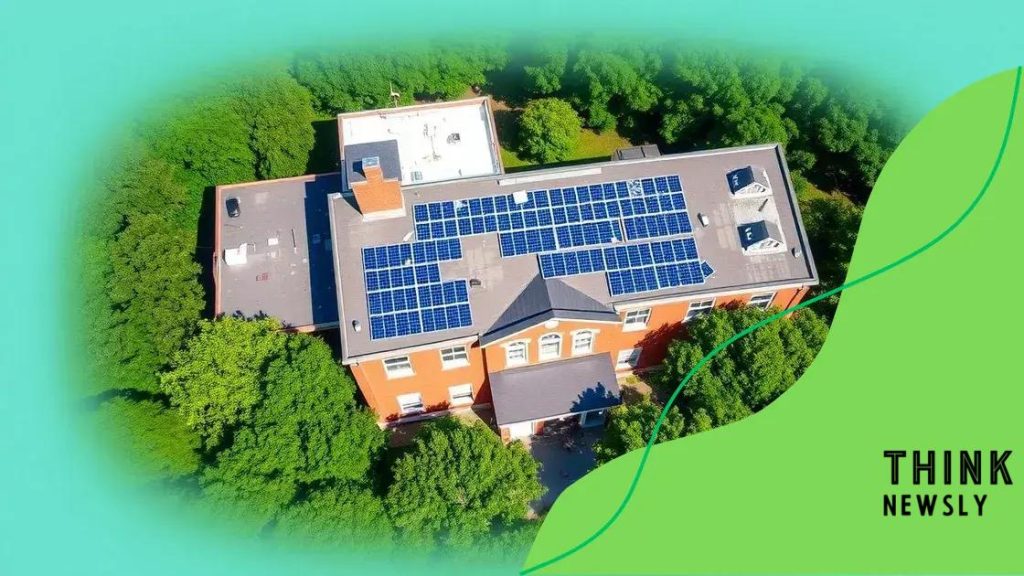Public schools use solar power to save money

Anúncios
Public schools use solar power to significantly reduce energy costs, enhance sustainability education, and foster community engagement, preparing students for a future focused on renewable energy solutions.
Public schools use solar power to not only save on energy costs but also to foster a more sustainable environment. Imagine the impact on students and the community. This article dives into how schools are leading the charge in renewable energy.
Anúncios
Benefits of solar energy for public schools
Using solar energy comes with numerous benefits for public schools. Not only does it reduce electricity costs, but it also promotes sustainability. Schools that utilize solar power enjoy long-term savings while contributing to a healthier planet.
Cost Savings
One of the most significant advantages of solar energy is the cost savings. By installing solar panels, schools can significantly lower their energy bills. This means that more funds can be directed towards educational resources and activities.
- Lower utility bills
- Access to state and federal incentives
- Reduced maintenance costs over time
These financial benefits can make a huge difference, especially in districts with tight budgets. Public schools can allocate saved funds to enhance student programs, upgrade technology, and improve facilities.
Anúncios
Environmental Impact
Another essential benefit of going solar is the positive environmental impact. Schools adopting solar power contribute to a reduction in greenhouse gas emissions. This action supports the fight against climate change and educates students about the importance of renewable energy.
- Reduction in carbon footprint
- Promotion of clean energy sources
- Creation of awareness about sustainability
By utilizing solar energy, public schools set an example for their communities, showcasing the importance of caring for our environment. Involving students in solar projects can also emphasize the relevance of renewable energy in their education.
Moreover, the educational benefits of solar power are significant. Schools can integrate renewable energy topics into their curricula, fostering interest in science, technology, engineering, and mathematics (STEM) subjects. This can help students understand energy production and its role in society.
Community Engagement
Public schools that implement solar energy projects often engage with their local communities. These initiatives can lead to partnerships with local businesses, governments, and environmental organizations. Collaboration can strengthen community ties while boosting local economies.
In conclusion, solar energy offers a multitude of benefits for public schools, including cost savings, a positive environmental impact, and opportunities for community engagement. By adopting this innovative energy source, schools not only enhance their operations but also positively influence their students and communities.
How solar power reduces operational costs
Solar power has become a valuable resource for public schools, leading to remarkable reductions in operational costs. By harnessing the sun’s energy, schools can significantly cut down on their utility expenses. This allows for better budget allocation and enhanced educational resources.
Lower Energy Bills
One of the most immediate benefits of installing solar panels is the reduction of energy bills. Schools that switch to solar energy can lower their electricity costs dramatically. This savings can amount to thousands of dollars annually.
- Increased energy independence
- Fixed energy rates over time
- Reduced reliance on traditional energy sources
These savings can free up funds for essential services like classroom supplies, technology updates, and extracurricular activities.
Long-Term Financial Benefits
Beyond just lower utility bills, schools investing in solar can take advantage of various financial incentives. Many governments offer grants and tax credits that can offset the costs of solar panel installation. This makes solar investment even more appealing.
Additionally, the maintenance costs for solar systems are generally low. With few moving parts, solar panels seldom require extensive repairs or replacements. This cost efficiency helps ensure that funds are directed towards student education rather than fixing aging infrastructure.
Schools can significantly reduce their operational costs while promoting self-sufficiency and sustainability. As these institutions shift towards renewable energy, they set an example for students about the importance of innovation in combating financial challenges.
Resilience Against Rising Energy Costs
Another significant advantage of using solar power is resilience against rising energy prices. In an era of fluctuating energy costs, schools that utilize solar panels can stabilize their budgets. This predictability makes financial planning easier.
By relying on solar energy, schools are less susceptible to sudden spikes in electricity prices. This stability allows schools to plan their budgets more accurately, ensuring better financial management and sustainability in the long run.
Success stories of schools using solar energy

Across the nation, many public schools have successfully implemented solar energy solutions, showcasing their commitment to sustainability and financial responsibility. These success stories highlight the numerous advantages solar brings to educational institutions.
California Schools Leading the Way
California has been at the forefront of adopting solar energy in schools. Numerous districts have set ambitious goals to install solar panels on their rooftops. Schools like the San Diego Unified School District are saving millions in energy costs. Their solar installations not only lower operating expenses but also provide valuable learning experiences for students.
- Significant reduction in energy costs
- Educational programs centered around renewable energy
- Community engagement and awareness initiatives
These schools serve as excellent examples of how solar power can transform educational environments while allowing students to learn about modern energy solutions.
Success in New York
In New York, many schools are also stepping up to utilize solar energy. Schools in the Bronx have partnered with local organizations to install solar panels, creating jobs and providing students with firsthand experience in renewable energy. This initiative not only addresses budget concerns but enhances local job training programs.
By incorporating solar projects into their curriculum, these schools promote real-world applications of science and technology. Students learn about energy efficiency and sustainability while benefiting from having a green environment to study in.
The financial gains are coupled with a sense of pride among the school community as they contribute positively to the environment. Schools using solar energy exemplify how educational institutions can be leaders in environmental stewardship.
Community Impact in Texas
In Texas, schools are generating a wave of enthusiasm for solar energy. Districts like Austin Independent School District have launched significant solar initiatives. They provide not just energy savings, but also foster community engagement, including local solar workshops for parents and residents.
The adopted solar projects empower students to become advocates for sustainability. While saving on energy expenses, these schools demonstrate the importance of adopting new technologies for a greener future. The impact of these projects goes beyond cost savings, as they inspire innovation and creativity among students.
Challenges faced in solar energy adoption
Despite the numerous benefits of solar energy in public schools, several challenges can hinder its adoption. Understanding these obstacles is vital for schools considering a transition to renewable energy.
Initial Costs
One of the primary challenges is the upfront costs associated with installing solar panels. Although prices have decreased over the years, schools may still face significant expenses to purchase and install the necessary equipment. Funding and financing options are available, but navigating these can be daunting for administrators.
- High installation costs
- Limited budget allocations for new projects
- Need for external funding sources
Schools often operate on tight budgets, making it hard to justify large initial investments in solar technology.
Regulatory Hurdles
Another barrier to adoption is navigating the complex regulations surrounding solar energy. Public schools must comply with local and state guidelines, which can vary significantly. This can lead to delays in project approvals.
Moreover, understanding the various incentives and rebates for solar installation can be challenging. Schools need to keep up with the constantly changing laws and policies related to renewable energy, making the process more complicated.
Maintenance Concerns
Once solar panels are installed, schools must also consider ongoing maintenance. While solar systems typically require low maintenance, there are still costs and responsibilities associated with ensuring they remain operational.
Many districts may not have the personnel trained to manage solar technology, which can lead to further challenges. Addressing these factors is crucial for maximizing the long-term benefits of solar energy.
Community and Stakeholder Buy-In
Gaining support from the community and key stakeholders is essential when considering solar energy implementation. Resistance from parents, staff, or local authorities can create obstacles to moving forward with projects.
Schools must take time to educate and involve their communities in the process, helping to build support and address concerns proactively. Engaging discussions about the benefits of using solar energy can foster a collaborative environment for project implementation.
Future of solar power in education
The future of solar power in education looks promising as more schools recognize its potential. Schools are increasingly looking to renewable energy solutions to address costs and environmental concerns. This shift is transforming the way that institutions manage their energy needs.
Growing Adoption Rates
More and more public schools are integrating solar energy systems into their buildings. This trend shows a significant increase in adoption rates across the nation as districts strive to reduce their carbon footprints and save on energy expenses.
- Expansion of solar programs in more states
- Increased funding and grants for solar projects
- Collaborations with local governments and businesses
As technological advancements continue, the cost of solar installations is expected to decrease further, making it accessible for even more schools.
Enhanced Learning Opportunities
Solar power in schools provides unique learning opportunities for students. By implementing solar energy systems, schools can incorporate renewable energy topics into their science and technology curricula. Students can engage with real-world applications of their studies.
Practical lessons about sustainability and energy conservation equip them with knowledge that is essential for the future. Schools are not just places for education; they become living laboratories where students can learn about innovative practices.
Community Engagement and Support
As schools adopt solar solutions, they can rally community support. Parents and local organizations often get involved in solar initiatives, providing funding and volunteer work. This community participation fosters a sense of shared responsibility for both education and the environment.
Schools can become hubs of education about renewable energy and sustainability, leading to greater community awareness and proactive initiatives. This involvement enhances the learning environment and drives home the importance of renewable resources.
Preparing for a Sustainable Future
The future of solar power in education is not just about energy savings; it also reflects a commitment to a sustainable future. Schools adopting these technologies are preparing students for a world where renewable energy plays a crucial role.
As global energy needs evolve, educators aim to create a knowledgeable and responsible generation. By leading the way in solar energy adoption, schools are equipping students with the tools to tackle future challenges.
FAQ – Frequently Asked Questions About Solar Power in Education
What are the main benefits of solar energy for schools?
Schools can save significantly on energy costs, enhance educational opportunities about sustainability, and build stronger community ties.
How can solar energy improve student learning?
By integrating solar power projects into the curriculum, students gain practical knowledge about renewable energy and environmental stewardship.
What challenges do schools face when adopting solar energy?
Challenges include initial installation costs, regulatory hurdles, maintenance concerns, and the need for community support.
What is the future outlook for solar power in education?
The future seems bright as more schools adopt solar energy, contributing to sustainability and preparing students for a renewable energy-focused world.





